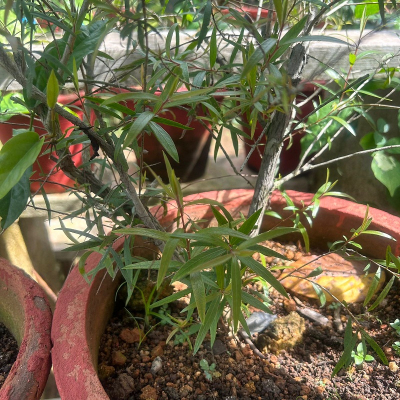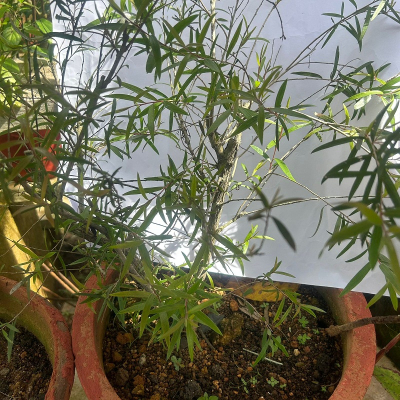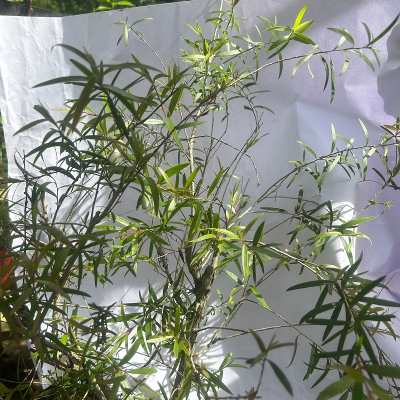Distribution and Habitat: Native to eastern Australia. Tree grows in inaccessible parts of dividing range of eastern Australia and is very sparsely distributed and confined to warmer (27-32°C) swamps by the coast. Occurrence of wild stands in swampy areas makes harvesting difficult. It is frost sensitive. It thrives in a relatively small area of New South Wales, in swampy low-lying land surrounding flood-prone river systems. Now its cultivation has spread all over world.
Botany: It develops into a small, evergreen tree of 5-7 m height, usually with a single trunk with flaky, exfoliating bark and white spring and summer flowers. Tree growth is moderate. Branches may be many or a few, and branching occurs low or high. In dense stands, a few branches grow almost vertically. Roots at base of stem are partly exposed and sometimes adventitious roots are also found.
- Bark: Consists of thin paper like layers of cork separated by thin fibrous layers. Bark which later peels off naturally is used by gardeners for filling hanging basket.
- Wood: Termite and water resistant and used in building construction and also as firewood.
- Leaves: Stiff, citrus scented with a uniform green color, glabrous, very narrow, alternate, ovate to lanceolate, entire and stouty petiolate.
- Flowers: Produced in dense clusters along stems, each flower with fine small petals and a tight bundle of stamens. Flowers are creamy white, sometimes yellow tinted, sessile in open or condensed terminal spikes. Flowers are bisexual.
- Fruit: Woody capsule, globular, less than 0.5 mm diameter, occurring in elongated clusters. Seeds are minute, brown, normally 10,000 numbers per gram and with very low viability.
Properties: Tea tree oil has antibacterial, antifungal, antiviral and anti-inflammatory properties and is employed in commercial pharmaceutical market. It is a broad spectrum disinfectant and is the greatest natural antiseptic of world.
Chemical constituents: Anti-microbial properties of oil are primarily attributed to terpinen-4-ol which is well tolerated by skin. Oil also contains significant levels of 1,8 cineole (3- 17 %), terpinolene and g terpinene (to 25 %) and limonene (to 5 %). Main constituent terpinen- 4-ol varies from 25-45 %. Cineole content shows much variation depending on habitat. Poor quality oil contains more cineole (10- 65%) which is an irritant. It also contains α- terpinene, p- cymene, terpinolene, α-terpineol, α -pinene, cadinene, viridiflorene and viridiflorol.
Uses:
- Oil is applied externally on skin for wound healing, for treating boils, rashes, cuts, tooth aches, gum infections, mouth ulcers, toe nail infections, athlete’s foot and scrapes and insect bites, stings and carbuncles.
- Oil is added in soaps and body washes. It is active against organisms which cause paronychia and aids in relief of pain, pressure and swelling.
- Tea tree is a traditional aboriginal remedy. Leaves are crushed in hand and the volatile oil is inhaled or used as infusions for cough, cold, head aches, sore throat and skin infections. It is taken internally for chronic and acute infections and also used in mouth washes and gum disease. In home remedies, tea tree oil is added to a vaporizer to cure chest congestion, to shampoo to destroy head lice and to a bath to remove persistent body odor.
- In aromatherapy, tea tree oil is used in recipes for colds, sore throat, coughs, acne, tooth aches, pyorrhea and sunburns. Mouth sores and gingivitis can be checked by mouth wash prepared by adding a few drops of tea tree oil into a cup of warm water. Oil gives protection against radiation damage.
- Fumigation of stored agricultural products is done using the oil against post harvest fungal pathogens.
- Leaves are used as a substitute for tea and also to flavour beer. Its foliage when steeped in water produces a brown tincture resembling tea. Tea is suitable for hedges and is popular as garden plants in Australia and other tropical areas.
Agro-technology:
Soil and climate: Tea tree grows well on a range of soils with adequate soil moisture but it can cope well with dry situations. It is not adapted to shady conditions and requires full sun for the best performance. It does well in poorly drained soils such as swampy areas, drainage lines and river banks. Plant prefers acid and neutral soils. It is not very cold hardy and does not tolerate temperatures below -7°c for long period.
Propagation: Direct seed sowing is rarely practiced. Seeds are either sown in seed beds composed of coarse sand and loam or in pots or later transplanted. Seeds are sown thinly at the rate of 0.5 g/ m2. Seeds germinate readily. Seeds sown in seed trays are planted out singly in pots when 4-6 weeks old. Field planting is done after frost. Adequate soil moisture should be assured at time of transplanting. Field establishment is low when transplanted from nursery beds compared to potted plants. Cuttings are also used as planting material after rooting in pots. Plant population will be 30,000 to 35,000 per hectare.
Fertilizer application: Fertilizer application is generally not practiced but occasional use of slow release fertilizers is beneficial. Crop requires low maintenance.
Plant protection: In Australia, tea tree is attacked by larvae of hepialid moths Aenetus ligniveren which first burrow horizontally into trunk and then vertically down.
Harvesting: First harvesting is done at 15-18 months and subsequently at 12-15 month intervals. Leaves and branches are harvested throughout the year and distilled. Stems should be cut when diameter is less than 2 cm and at 5-10 cm above soil level. Foliage yield will be 8-10 tonnes/ ha. Leaf oil content is lower in cooler months. In cold regions, harvesting should be so planned that emergence of new shoots will not coincide with frost. Oil yield will be around 70 kg/ ha during first year and increases and stabilizes by third year to around 150 kg/ha.
Processing: On steam distillation, fresh leaves yield 2-3 % lemon tinted essential oil. Tea tree oil is non-irritant. Crude oil is dark yellowish green but steam distilled oil is white to pale yellowish green in appearance and scent resembles camphor. Oil yield is lower in winter compared to that in summer.




